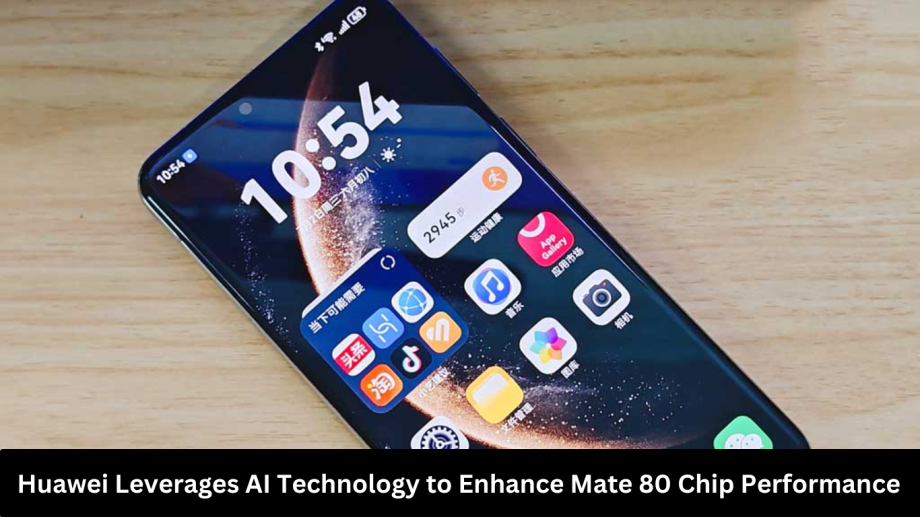Huawei, one of the world’s leading technology innovators, continues to redefine the boundaries of mobile performance and artificial intelligence integration.
- The Evolution of Huawei’s Chipset Innovation
- Key AI Technologies Powering the Mate 80 Chip
- 1. On-Device Neural Processing Unit (NPU)
- 2. AI-Driven Power Management
- 3. AI Performance Optimization
- 4. AI-Enhanced Graphics and Imaging
- Benchmark Results & Real-World Performance
- Impacts of AI on 5G and Connectivity
- Enhanced User Experience Through AI Personalization
- Security and Privacy with AI
- Competitive Edge Over Other Flagship Chips
- Challenges and Considerations
- Future Outlook: AI in Huawei’s Ecosystem
- What It Means for Consumers and the Industry
- Frequently Asked Question
- What AI technologies are used in the Huawei Mate 80 chip?
- How does AI improve performance in the Huawei Mate 80 series?
- Does AI help with gaming and graphics on the Mate 80?
- Is the AI on the Mate 80 chip cloud-based or on-device?
- How does AI improve battery life on the Mate 80?
- What are the camera benefits of AI in the Mate 80?
- How does the Mate 80 chip compare to other flagship chips in terms of AI?
- Conclusion
With the highly anticipated launch of the Huawei Mate 80 series, the Chinese tech giant has taken a bold step forward by infusing cutting-edge AI technology into the core of its latest chipset, the Kirin 9000S+.
This strategic fusion is not only elevating smartphone performance but also reshaping the way devices adapt to user behavior, optimize power, and deliver intelligent computing experiences.
The Evolution of Huawei’s Chipset Innovation
Huawei has long invested in chip development through its semiconductor arm, HiSilicon. From the early days of the Kirin series to the latest Kirin 9000 iterations, the company has consistently pushed the envelope in mobile processing power and efficiency.
With the Mate 60 series, Huawei introduced the Kirin 9000S, developed domestically using advanced chip fabrication processes despite global sanctions.
The Mate 80 series is expected to feature the Kirin 9000S+ or a next-gen processor—now equipped with AI-enhanced features that offer adaptive performance, real-time optimization, and deep learning capabilities right on the device.
Key AI Technologies Powering the Mate 80 Chip
Huawei’s integration of AI into the Mate 80 chip is not just a buzzword—it’s a transformative technology that brings real-world benefits to users. Here are the key AI technologies embedded in the new chip:
1. On-Device Neural Processing Unit (NPU)
Huawei’s AI architecture revolves around a dedicated Neural Processing Unit, which enables the phone to process AI tasks locally rather than sending data to the cloud. This results in:
-
Faster AI-based computations
-
Better privacy and security
-
Lower latency in real-time tasks such as image recognition, voice processing, and augmented reality
2. AI-Driven Power Management
One of the standout features of the Mate 80 chip is its intelligent power allocation system. Using AI algorithms, the chip dynamically manages CPU, GPU, and NPU workloads, significantly reducing power consumption without sacrificing performance. This leads to:
-
Longer battery life
-
Reduced overheating
-
Smarter app management and background task prioritization
3. AI Performance Optimization
AI learns how users interact with their phones and allocates system resources accordingly. The chip continuously fine-tunes performance based on usage patterns. For example:
-
Gaming performance is optimized during active sessions
-
Background apps are intelligently throttled or boosted
-
RAM management becomes more predictive and adaptive
4. AI-Enhanced Graphics and Imaging
The Mate 80 chip also integrates AI into its ISP (Image Signal Processor), resulting in:
-
Better low-light photography
-
Smarter scene recognition
-
Real-time AI video enhancements
-
Improved object tracking and motion capture for videos
Benchmark Results & Real-World Performance
Preliminary benchmark leaks and early testing of the Kirin 9000S+ show notable improvements in AI performance compared to previous models. Key highlights include:
-
20–30% increase in AI task processing speed
-
Enhanced GPU performance with AI rendering optimizations
-
More efficient thermal management under heavy loads
In real-world usage, users report smoother multitasking, faster app launches, and minimal frame drops during gaming—all thanks to AI’s ability to predict and prioritize tasks intelligently.
Impacts of AI on 5G and Connectivity
Huawei’s AI integration extends to 5G modem performance as well. With AI-powered signal optimization, the Mate 80 chip can:
-
Adapt to changing network conditions in real time
-
Enhance signal strength in weak coverage areas
-
Reduce power draw during idle connectivity periods
This ensures a seamless browsing, streaming, and gaming experience, even in fluctuating 5G environments.
Enhanced User Experience Through AI Personalization
AI in the Mate 80 series doesn’t stop at performance—it also enhances the user experience at every touchpoint. Some key AI-powered features include:
-
AI voice assistant that learns from user preferences
-
Adaptive display brightness and refresh rate
-
Smart notifications and suggestions based on usage patterns
-
Intelligent camera settings based on real-time scene analysis
The phone essentially becomes a personalized assistant, adapting not only to technical needs but also to your lifestyle.
Security and Privacy with AI
A major concern in today’s digital landscape is privacy. Huawei addresses this by ensuring that its AI functions operate on-device. That means:
-
No need to send sensitive data to cloud servers
-
Faster response time and real-time analytics
-
Greater control over what data is processed and stored
Moreover, Huawei has introduced AI-based anomaly detection, which can detect suspicious app behavior, phishing attempts, or malware in real-time.
Competitive Edge Over Other Flagship Chips
The AI enhancements in the Mate 80 chip place Huawei in a strong position against competitors like Apple’s A17 Pro and Qualcomm’s Snapdragon 8 Gen 3. Here’s how:
| Feature | Huawei Mate 80 (Kirin 9000S+) | Snapdragon 8 Gen 3 | Apple A17 Pro |
|---|---|---|---|
| On-device AI NPU | ✔️ | ✔️ | ✔️ |
| AI Power Optimization | ✔️ Advanced | ✔️ | ✔️ |
| Real-Time AI Imaging | ✔️ Superior | ✔️ | ✔️ |
| 5G AI Modem | ✔️ Integrated | ✔️ | ✔️ |
| AI Personalization | ✔️ Custom-Tuned | Limited | Moderate |
Huawei’s ability to develop both hardware and software in-house gives it an advantage in tightly integrating AI throughout the system stack.
Challenges and Considerations
Despite the advancements, Huawei faces several challenges in fully leveraging AI technologies:
-
Limited Access to Global Chip Supply Chains: Due to ongoing U.S. sanctions, Huawei has had to develop domestic alternatives, which might lag slightly in raw fabrication technologies.
-
App Ecosystem Compatibility: Some third-party apps may not yet fully utilize the AI enhancements, especially outside the Chinese market.
-
AI Processing Overhead: While on-device AI offers great benefits, it can increase the chip’s complexity and heat generation if not properly optimized.
However, Huawei has shown resilience and ingenuity in overcoming these hurdles, as evidenced by its successful rollout of the Mate 60 and Pura 70 series.
Future Outlook: AI in Huawei’s Ecosystem
Huawei’s AI strategy doesn’t end with the Mate 80 chip. The company is building a full-stack AI ecosystem that includes:
-
HarmonyOS Next: Huawei’s new OS natively supports AI-powered workflows across devices
-
Cross-device AI integration: Seamless sync between phones, tablets, wearables, and smart home devices
-
AI in productivity tools: Smart document scanning, translation, note-taking, and more
This holistic AI approach means that the benefits of AI on the Mate 80 chip will extend to Huawei’s broader tech ecosystem.
What It Means for Consumers and the Industry
For consumers, Huawei’s AI-driven Mate 80 chip represents:
-
Smarter phones that learn from your behavior
-
More efficient devices that last longer on a charge
-
Enhanced multimedia experiences driven by real-time optimization
For the mobile industry, it’s a sign that AI is no longer a feature—it’s a necessity. Chipmakers, OEMs, and software developers will need to prioritize AI integration to stay competitive.
Frequently Asked Question
What AI technologies are used in the Huawei Mate 80 chip?
Huawei’s Mate 80 chip, likely the Kirin 9000S+, integrates advanced Neural Processing Units (NPUs) for on-device AI computation. It also uses AI for power management, camera enhancements, user behavior prediction, and 5G signal optimization.
How does AI improve performance in the Huawei Mate 80 series?
AI helps the Mate 80 chip by optimizing resource allocation, reducing power consumption, and improving thermal efficiency. It learns user habits to deliver smarter multitasking, faster app launches, and real-time system tuning for peak performance.
Does AI help with gaming and graphics on the Mate 80?
Yes. AI enhances GPU performance by enabling dynamic frame rate adjustment, resource prioritization, and real-time image rendering, delivering smoother gameplay and more efficient graphics processing.
Is the AI on the Mate 80 chip cloud-based or on-device?
Huawei uses on-device AI processing through its integrated NPU. This ensures faster response times, greater privacy, and offline functionality, as data doesn’t need to be sent to external servers.
How does AI improve battery life on the Mate 80?
The chip uses AI-powered power management to intelligently regulate how apps and system functions consume energy. It reduces background activity, adapts screen refresh rates, and controls thermal output to extend battery life significantly.
What are the camera benefits of AI in the Mate 80?
AI enhances the camera system by enabling real-time scene recognition, low-light improvements, motion tracking, and intelligent image processing. It helps users capture clearer, sharper, and more dynamic photos and videos.
How does the Mate 80 chip compare to other flagship chips in terms of AI?
The Kirin 9000S+ holds its own against competitors like Apple’s A17 Pro and Snapdragon 8 Gen 3 in AI performance. While manufacturing constraints may limit raw power, Huawei’s tight software-hardware AI integration makes the Mate 80 highly competitive in real-world use.
Conclusion
Huawei’s use of AI technology to enhance the Mate 80 chip performance is a landmark achievement in the evolution of mobile computing.
Through a tightly integrated AI architecture that spans power management, graphics, connectivity, and personalization, Huawei is delivering a smarter, faster, and more user-centric smartphone experience.
Despite facing supply chain limitations and geopolitical barriers, Huawei’s commitment to innovation shines through.
The Mate 80 series, powered by an AI-enhanced Kirin chipset, not only raises the bar for flagship performance but also underscores the potential of AI as the future of mobile technology.








